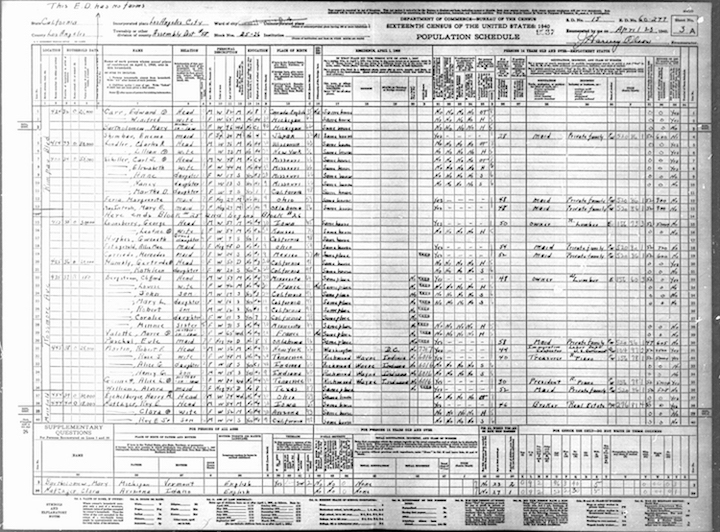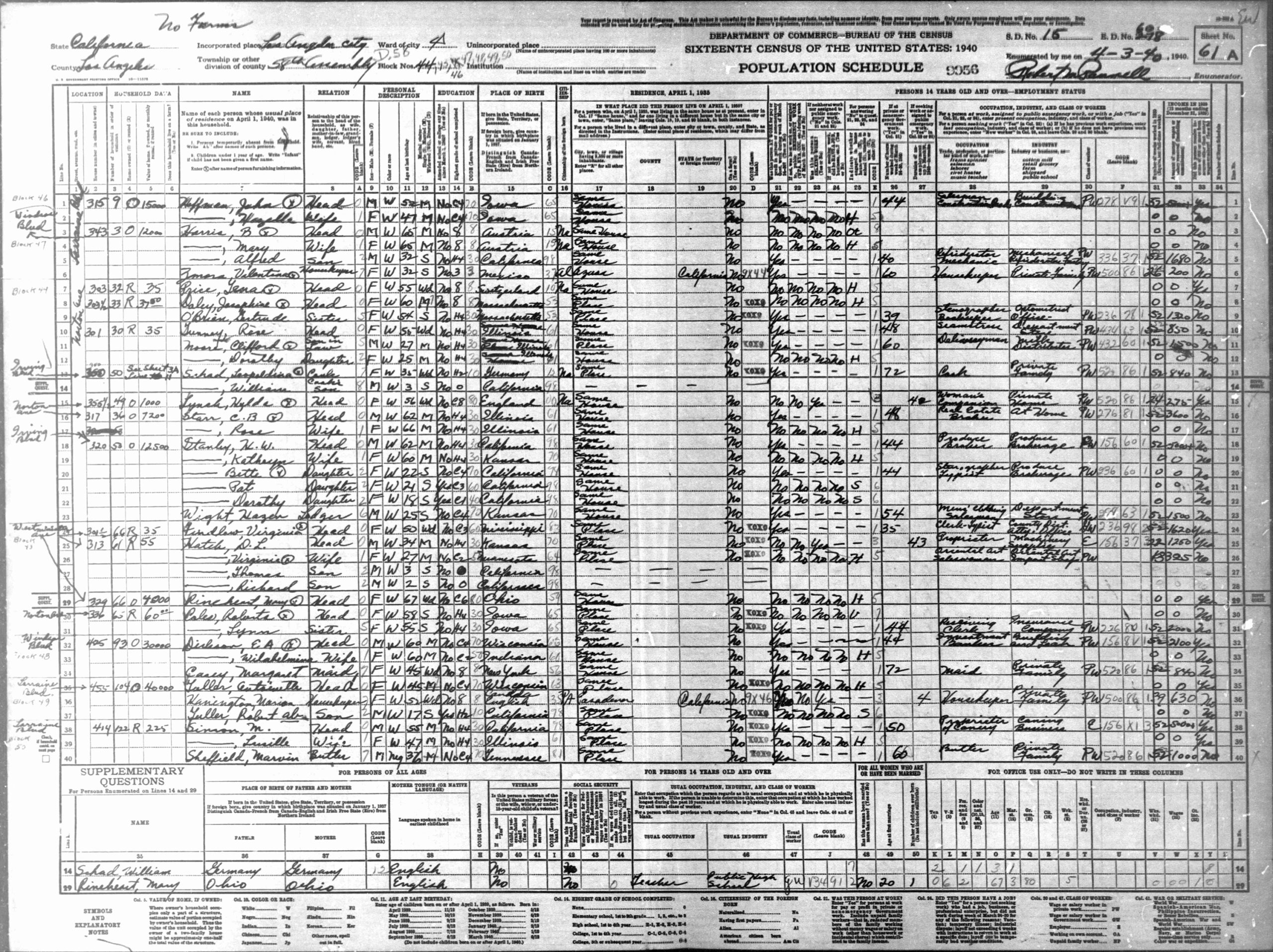Trace history of your home with the 1940 census
With the 2020 Census just around the corner, the Larchmont Chronicle is searching through the records of the 1940 census — which were finally released to the public in 2012 after being held for the mandatory 72-year waiting period — to show our readers a way to learn a bit about their homes’ histories.

1940 CENSUS form for 400 Rimpau Blvd. shows that the Schiller family, all of whom but one daughter were born in Missouri, lived in the home. The form also gives data like employment, income and more. The 2020 Census starts this month.
The U.S. Census is taken every 10 years. The numbers collected dictate the number of seats each state gets in the House of Representatives. The next census will take place this month — in March.
Ever wonder who lived in your house over half a century ago? What they did for a living? How they lived? The census archives are aiming to answer those questions by providing us with a look at the everyday people of our localities, the ones who don’t always make it into the history books.
The official website for the 1940 Census, a part of the National Archives, grants visitors full access to the 1940 Census images, maps and descriptions. To give an accurate-as-possible look at the nation in 1940, the site contains 3.8 million images, taken from over 4,000 rolls of microfilm.
Look into the past
We took a look into the past at some historic homes in the Greater Wilshire area.
One example is the residence at 400 S. Rimpau Blvd. (the home right behind the Nat King Cole home on Fourth and Muirfield). Missouri-natives Carl J. Schiller, his wife Elizabeth, and their 17-year-old daughter Anne once occupied that house. According to the Census Schedule, although Schiller had a college education, he had not worked the previous year, and was coded as OT, meaning that he was unable to work. Elizabeth had a high school education, and she was marked down as caring for the household. Anne, their daughter, was unemployed and in high school.will yield multiple results. In order to narrow it down, you will be given the option to add a cross street. This will usually narrow it down to one document. However, each document is multiple pages long, so if you don’t see the house number you are looking for right away, don’t despair! You may have to review several pages. (The information for the Chandlers’ house was on page 33 out of 40.)
The thing you will need most of all is patience. I had to go through multiple pages of the Census Schedule before I found the addresses I sought.

CENSUS form for 361 N. Citrus.
If you’re looking for a specific ancestor, but don’t know the address, you will first have to look him or her up in the 1930 Census. While this will only tell you where the ancestor lived at the top of 1930, it will at least narrow down your search. You must provide the first name, last name, and state of residence.
To get to the 1930 Census, once you are on the “Getting Started” page, scroll all the way down to the bottom … to the section that says “Still need help?” and click on the orange help button. Once on the help page, you can press the button that says “Search 1930 Census Records by Name.” Once you enter the pertinent information, it will pull up that person’s enumeration district (ED) in 1930. From there, you can choose to view the 1940 ED results that correspond with the 1930 results.
The website can be a little frustrating to navigate because, at times, it is slow to zoom, scroll, or load. Also, since the census schedules are scans of actual, handwritten documents, they are not always super legible, and they can be hard to read. However, your persistence will pay off. Once you track down the address, you will have access to a plethora of information, including names, age, race, occupation, and education level.
I also found it incredibly helpful to have a blank copy of the Census schedule on hand, as it made reading the categories and columns a lot easier. That can be found by Googling 1940 Census Schedule Blank.
Get started with your research at 1940census.archives.gov.
Another example: Last October, the historic Tudor-style home at 361 N. Citrus was torn down. Since the house had stood there since 1927, we were able to track down some of the history of its inhabitants. In 1940, Attorney Kenyon B. Lee rented the house for $100 per month, and he lived there with his wife Hazel and son Kenyon F. Lee Jr. Kenyon had five years of college education, and, while he worked 54 hours per week for 52 weeks, his salary was reported as zero.
Dorothy Chandler Estate
Up next is a house that has gone by many names in its lifetime, including “Los Tiempos,” “The Dorothy Chandler Estate,” and “The White House of the West.” This multi-monikered house is best known for once being the home of Dorothy and Norman Chandler. However, according to the Census, in 1940 Antoinette Fuller, her son Robert, and their Canadian-English housekeeper, Marion Harington, occupied the house. One of the more expensive ones on the block, the house was valued at $40,000. Ms. Fuller had a college education, but she did not work, and for working 39 weeks as housekeeper, Harington earned $630 for the year.
Easier than you think
While accessing the archives can seem a little overwhelming at first glance, it’s really not. Here is how I made my way through:
The website is most easily navigated if you have a street address. If you’re curious about the history of your home, on the homepage of the 1940 Census webpage, 1940census.archives.gov, click on the big orange “Get Started” button.
On the “Getting Started” page, scroll down until you see the title, “Do you know the location where the person lived?” and press the orange “Start Your Search” button.
To begin, enter the state, county, city and street. Once you enter this information, it will yield multiple results. In order to narrow it down, you will be given the option to add a cross street. This will usually narrow it down to one document. However, each document is multiple pages long, so if you don’t see the house number you are looking for right away, don’t despair! You may have to review several pages. (The information for the Chandlers’ house was on page 33 out of 40.)
The thing you will need most of all is patience. I had to go through multiple pages of the Census Schedule before I found the addresses I sought.
If you’re looking for a specific ancestor, but don’t know the address, you will first have to look him or her up in the 1930 Census. While this will only tell you where the ancestor lived at the top of 1930, it will at least narrow down your search. You must provide the first name, last name, and state of residence.
To get to the 1930 Census, once you are on the “Getting Started” page, scroll all the way down to the bottom … to the section that says “Still need help?” and click on the orange help button. Once on the help page, you can press the button that says “Search 1930 Census Records by Name.” Once you enter the pertinent information, it will pull up that person’s enumeration district (ED) in 1930. From there, you can choose to view the 1940 ED results that correspond with the 1930 results.

CENSUS form for 455 Lorraine Blvd., the Norman and Dorothy Chandler home.
The website can be a little frustrating to navigate because, at times, it is slow to zoom, scroll, or load. Also, since the census schedules are scans of actual, handwritten documents, they are not always super legible, and they can be hard to read. However, your persistence will pay off. Once you track down the address, you will have access to a plethora of information, including names, age, race, occupation, and education level.
I also found it incredibly helpful to have a blank copy of the Census schedule on hand, as it made reading the categories and columns a lot easier. That can be found by Googling 1940 Census Schedule Blank.
Get started with your research at 1940census.archives.gov.
By Julia Stier
Category: News

This is a great, easy way to find a census record by address–thank you! I have been using Steve Morse’s “ED Finder” at https://stevemorse.org/census/unified.html to do the same thing, but it is more complicated.
Also, I just wanted to mention, FamilySearch.org provides free access to all of the digitized censuses, as well. This is an easier way than the census.archives.gov site to search by name (if you know the name of the person you’re researching). You’ll need to create an account with FamilySearch.org to view the records, but it’s free and they don’t hassle you.
I would like to find my paternal and maternal grandparents my mother was born in 1922 my dad approximately 1910 during that time no birth records were maintained i believe my grandparents were slave descendants
I just want to trace my great grandmother’s place of birth before moving to Griffin Georgia in the years before 1900. I was told she married in CedarTown Georgia.